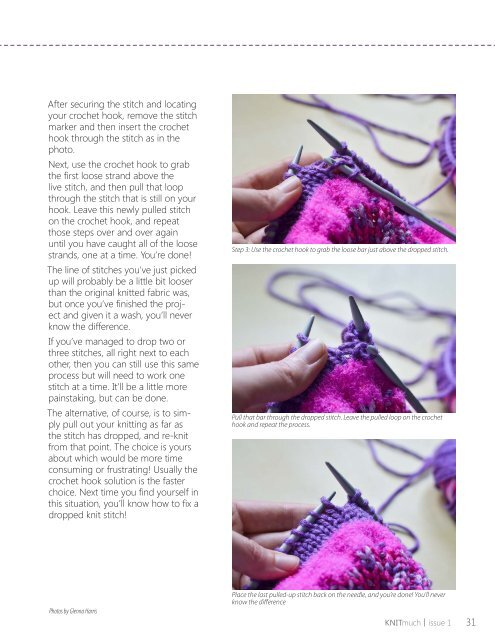KNITmuch | Issue 01
Here it is! The much anticipated FREE Premiere issue of KNITmuch Magazine! We’re extremely excited to launch this first issue featuring a full 52 pages of knitting projects, tips, techniques, and products. In this issue, you’ll find a review of the NEW Downton Abbey Yarn Collection and the irresistible Top This! yarn kit. See the Crawley Vest and Budding Romance Shawl patterns for great project ideas using the new Downton Abbey yarns. We also review a variety of project ideas to make with Red Heart’s Cutie Pie and Sashay yarns. We go back to knitting basics to inspire new knitters to expand their knowledge of knitting and get to the bottom of key technical knitting terms and skills. Enjoy exploring our very first issue. Save it in your favorites, share it with your knitting friends!
Here it is! The much anticipated FREE Premiere issue of KNITmuch Magazine! We’re extremely excited to launch this first issue featuring a full 52 pages of knitting projects, tips, techniques, and products.
In this issue, you’ll find a review of the NEW Downton Abbey Yarn Collection and the irresistible Top This! yarn kit. See the Crawley Vest and Budding Romance Shawl patterns for great project ideas using the new Downton Abbey yarns. We also review a variety of project ideas to make with Red Heart’s Cutie Pie and Sashay yarns. We go back to knitting basics to inspire new knitters to expand their knowledge of knitting and get to the bottom of key technical knitting terms and skills.
Enjoy exploring our very first issue. Save it in your favorites, share it with your knitting friends!
You also want an ePaper? Increase the reach of your titles
YUMPU automatically turns print PDFs into web optimized ePapers that Google loves.
After securing the stitch and locating<br />
your crochet hook, remove the stitch<br />
marker and then insert the crochet<br />
hook through the stitch as in the<br />
photo.<br />
Next, use the crochet hook to grab<br />
the first loose strand above the<br />
live stitch, and then pull that loop<br />
through the stitch that is still on your<br />
hook. Leave this newly pulled stitch<br />
on the crochet hook, and repeat<br />
those steps over and over again<br />
until you have caught all of the loose<br />
strands, one at a time. You’re done!<br />
The line of stitches you’ve just picked<br />
up will probably be a little bit looser<br />
than the original knitted fabric was,<br />
but once you’ve finished the project<br />
and given it a wash, you’ll never<br />
know the difference.<br />
If you’ve managed to drop two or<br />
three stitches, all right next to each<br />
other, then you can still use this same<br />
process but will need to work one<br />
stitch at a time. It’ll be a little more<br />
painstaking, but can be done.<br />
The alternative, of course, is to simply<br />
pull out your knitting as far as<br />
the stitch has dropped, and re-knit<br />
from that point. The choice is yours<br />
about which would be more time<br />
consuming or frustrating! Usually the<br />
crochet hook solution is the faster<br />
choice. Next time you find yourself in<br />
this situation, you’ll know how to fix a<br />
dropped knit stitch!<br />
Step 3: Use the crochet hook to grab the loose bar just above the dropped stitch.<br />
Pull that bar through the dropped stitch. Leave the pulled loop on the crochet<br />
hook and repeat the process.<br />
Photos by Glenna Harris<br />
Place the last pulled-up stitch back on the needle, and you’re done! You’ll never<br />
know the difference<br />
<strong>KNITmuch</strong> | issue 1<br />
31

















